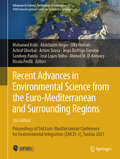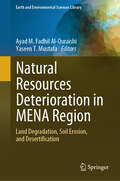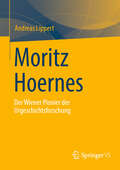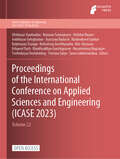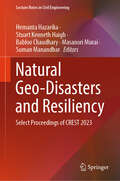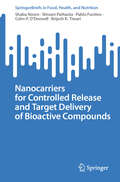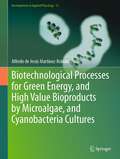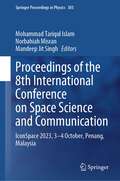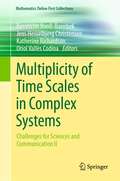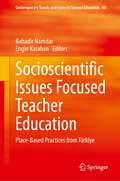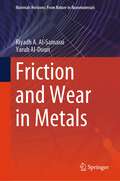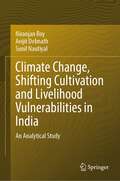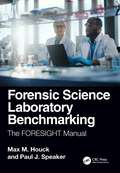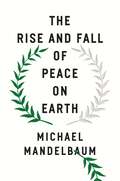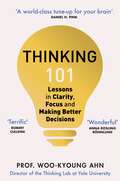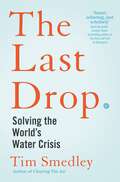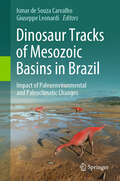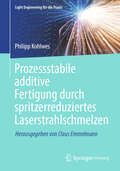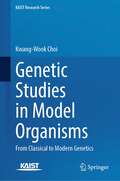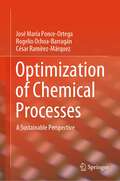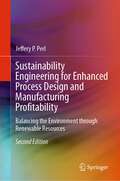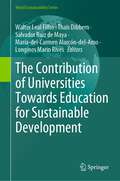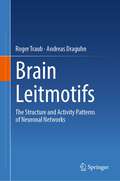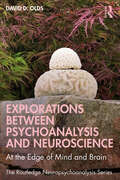- Table View
- List View
Recent Advances in Environmental Science from the Euro-Mediterranean and Surrounding Regions: Proceedings of 3rd Euro-Mediterranean Conference for Environmental Integration (EMCEI-3), Tunisia 2021 (Advances in Science, Technology & Innovation)
by Mohamed Ksibi Abdelazim Negm Olfa Hentati Achraf Ghorbal Arturo Sousa Jesus Rodrigo-Comino Sandeep Panda José Lopes Velho Ahmed M. El-Kenawy Nicola PerilliThis edited book includes over one hundred and eighty short papers that were presented during the third edition of EMCEI, which was held in Sousse, Tunisia, in June 2021. Nowadays, experts as well as most of the general public know that the Mediterranean and surrounding regions are facing environmental degradation that is accelerating at an unprecedented rate. The main causes are the natural and human induced climate change, increasing pollution, urban growth, and the overexploitation and unsustainable use of resources due to rapid population growth. The effects are seen in several indicators such as the warming, more frequent extreme events, severe droughts, water shortages, contraction of natural resources, changes in land use and landscape deterioration, decreasing agricultural yields, biodiversity loss, deterioration of the ecosystems, corrosion of the natural coastal environment, sea-level rise, and ocean acidification. In addition to these more recent issues, the Mediterranean and surrounding region naturally experience a number of hazards such as floods, droughts, desertification, fires, catastrophic forest diebacks, earthquakes, and volcanic eruptions. By presenting a wide range of environmental topics and new findings relevant to a variety of problems in these regions, this book appeals to anyone working in the subject area and especially students interested in learning more about new developments in environmental research initiatives in light of the worsening environmental degradation of the Mediterranean and surrounding areas, making environmental and resource protection an increasingly important issue that impedes sustainable development and social well-being. The book addresses emerging environmental issues along with new challenges by focusing on innovative approaches that contribute to achieving a sustainable environment in and around the Mediterranean Sea and by highlighting to decision makers from relevant sectors the environmental considerations that should be integrated into their own activities.
Natural Resources Deterioration in MENA Region: Land Degradation, Soil Erosion, and Desertification (Earth and Environmental Sciences Library)
by Ayad M. Fadhil Al-Quraishi Yaseen T. MustafaLand deterioration, drought, desertification, and water resources shrinkage threaten natural resources, negatively impacting environmental, economic, and political stability. The increasing occurrence of climate change (extremes) impacts land degradation processes, soil erosion by water and wind, and salinization. The researchers have invested several years of scientific research in natural resources deterioration, including soil degradation and erosion, land degradation, desertification, and climate changes, which are interesting enough. However, the link between science and policymaking appears to be less active as serious actions do not take fast. The eighteen chapters of this book focus more on topics related to natural resources deterioration, such as land degradation, desertification, drought, climate change, and analysis of numerous case studies. This book presents experts' overviews, study results, experiences, and knowledge of natural resources deterioration in MENA countries. It attracts researchers, experts, scholars, scientists, academics, students, practitioners, graduates, or anybody interested in land degradation, desertification, climate change, and natural hazards that fall within natural resources deterioration. Therefore, researchers keep continuing to do their investigations and produce results that convince stakeholders and policymaking to act immediately towards protecting natural resources and their sustainability.
Moritz Hoernes: Pionier der Urgeschichtsforschung
by Andreas LippertDer Band ist eine Biografie des ersten Lehrkanzelinhabers für Prähistorische Archäologie im deutschen Sprachraum. Nach einer längeren Zeit von Forschungen in Bosnien und der Herzegowina fand Hoernes eine Anstellung in der Prähistorischen Sammlung des Naturhistorischen Hofmuseums in Wien. Hier erst entschied er sich für urgeschichtliche Forschungen. Er habilitierte sich für das Fach 1892 und wurde bereits 1899 zum außerordentlichen Univ.-Professor an der Universität Wien ernannt. 1911 erfolgte dann seine Berufung als ordentlicher Univ.-Professor an dieser Universität. Hoernes verfasste einige bedeutende Übersichtswerke zur Urgeschichte in Europa, die noch heute Geltung haben, und zahlreiche Fachbeiträge.
Proceedings of the International Conference on Applied Sciences and Engineering (Atlantis Highlights in Engineering #22)
This is an open access book.We kindly welcome to all academicians, researchers, scientists, engineers and graduate students in the related fields to submit their original research papers. Applications in engineering science that require expertise in mathematics, physics and chemistry. Its mission is to become a voice of the applied science community, addressing researchers and practitioners in different areas ranging from mathematics, physics, and chemistry to all related braches of the engineering, presenting verifiable computational methods, findings, and solutions.The Conference provided a setting for discussing recent developments in various engineering and applied science topics, including Mathematics, Chemistry, Physics, Computational science, Material science, Environmental Science and Chemical engineering.The submitted conference papers will be subjected to stringent peer review and carefully evaluated based on originality and clarity of exposition. All the accepted papers will be published in the conference proceedings. The conference provides opportunities for the attendants to share new ideas, experiences in Applied Sciences and Engineering and to establish collaboration for the future.
Natural Geo-Disasters and Resiliency: Select Proceedings of CREST 2023 (Lecture Notes in Civil Engineering #445)
by Hemanta Hazarika Stuart Kenneth Haigh Babloo Chaudhary Masanori Murai Suman ManandharThis book presents select proceedings of the 2nd International Conference on Construction Resources for Environmentally Sustainable Technologies (CREST 2023), and focuses on sustainability, promotion of new ideas and innovations in design, construction and maintenance of geotechnical structures with the aim of contributing towards climate change adaptation and disaster resiliency to meet the UN Sustainable Development Goals (SDGs). It presents latest research, information, technological advancement, practical challenges encountered, and solutions adopted in the field of geotechnical engineering for sustainable infrastructure towards climate change adaptation. This volume will be of interest to those in academia and industry alike.
Nanocarriers for Controlled Release and Target Delivery of Bioactive Compounds (SpringerBriefs in Food, Health, and Nutrition)
by Shaba Noore Shivani Pathania Pablo Fuciños Colm P. O'Donnell Brijesh K. TiwariThis brief provides a comprehensive overview of nanocarriers used for nanoencapsulation of bioactive compounds. It includes the basis of encapsulation mechanism, encapsulation efficiency, controlled release, target delivery, and its application in food, nutraceuticals, pharmaceuticals and cosmeceuticals.
Biotechnological Processes for Green Energy, and High Value Bioproducts by Microalgae, and Cyanobacteria Cultures (Developments in Applied Phycology #13)
by Alfredo de Jesús Martínez-RoldánMicroalgae and cyanobacteria are a very diverse group of photosynthetic microorganisms with many applications. Some of them are related to the accumulation of molecules involved in specific metabolic pathways such as pigments, fatty acids, polyunsaturated fatty acids, carbohydrates, amino acids, etc. Also, there are uses of the biomass related to the exploitation of physiological necessities such as the absorption of essential nutrients (the removal of nitrogen and phosphorus from wastewater, the capture of CO2 from the fixation of nitrogen, etc.). Nevertheless, the evaluation in financial and life-cycle aspects is necessary to ensure the industrial application of the processes. The objective of the book is to analyze innovative applications of microalgae and cyanobacteria to develop environmental-friendly processes for removal of pollutants, wastewater treatment, production of high-value products or bioenergy, and finally evaluate the feasibility of the processes both ineconomic and sustainability aspects.
Proceedings of the 8th International Conference on Space Science and Communication: IconSpace 2023, 3–4 October, Penang, Malaysia (Springer Proceedings in Physics #303)
by Mohammad Tariqul Islam Norbahiah Misran Mandeep Jit SinghThis book presents peer-reviewed articles from the 8th International Conference on Space Science and Communication (IConSpace 2023), held at Penang in Malaysia. It addresses complications of ground-breaking initiatives and solutions for space science and communications research, telecommunications, and meteorology. With the theme Advanced Space Technology: Accelerating Global Agenda will provide valid information to understand trends, evaluate needs, and create global development policies and programs in the best interest of all. It brings together researchers, engineers, geospatialist, meteorologists, astronomers, and practitioners in order to present the latest applications in space science, telecommunications, meteorology, remote sensing, and related fields.
Multiplicity of Time Scales in Complex Systems: Challenges for Sciences and Communication II (Mathematics Online First Collections)
by Bernhelm Booß-Bavnbek Jens Hesselbjerg Christensen Katherine Richardson Oriol Vallès CodinaNote to the interested reader to have a look at the companion to this volume Challenges for Sciences and Communication I | ISBN: 978-3-031-28048-1.This highly interdisciplinary volume brings together a carefully curated set of case studies examining complex systems with multiple time scales (MTS) across a variety of fields: materials science, epidemiology, cell physiology, mathematics, climatology, energy transition planning, ecology, economics, sociology, history, and cultural studies. The book addresses the vast diversity of interacting processes underlying the behaviour of different complex systems, highlighting the multiplicity of characteristic time scales that are a common feature of many and showcases a rich variety of methodologies across disciplinary boundaries. Self-organizing, out-of-equilibrium, ever-evolving systems are ubiquitous in the natural and social world. Examples include the climate, ecosystems, living cells, epidemics, the human brain, and many socio-economic systems across history. Their dynamical behaviour poses great challenges in the pressing context of the climate crisis, since they may involve nonlinearities, feedback loops, and the emergence of spatial-temporal patterns, portrayed by resilience or instability, plasticity or rigidity; bifurcations, thresholds and tipping points; burst-in excitation or slow relaxation, and worlds of other asymptotic behaviour, hysteresis, and resistance to change. Chapters can be read individually by the reader with special interest in such behaviours of particular complex systems or in specific disciplinary perspectives. Read together, however, the case studies, opinion pieces, and meta-studies on MTS systems presented and analysed here combine to give the reader insights that are more than the sum of the book’s individual chapters, as surprising similarities become apparent in seemingly disparate and unconnected systems. MTS systems call into question naïve perceptionsof time and complexity, moving beyond conventional ways of description, analysis, understanding, modelling, numerical prediction, and prescription of the world around us. This edited collection presents new ways of forecasting, introduces new means of control, and – perhaps as the most demanding task – it singles out a sustainable description of an MTS system under observation, offering a more nuanced interpretation of the floods of quantitative data and images made available by high- and low-frequency measurement tools in our unprecedented era of information flows.
Socioscientific Issues Focused Teacher Education: Place-Based Practices from Türkiye (Contemporary Trends and Issues in Science Education #60)
by Bahadir Namdar Engin KarahanThis book explores place-based pedagogies in the context of socioscientific issues in Türkiye. From local and global contexts, it delves into research-based learning activities for science teacher educators, offering insights to educators worldwide.The book aims to empower teachers to provide students with learning experiences centered on local socioscientific issues essential for developing scientifically literate citizens. Each chapter showcases effective practices, focusing on local topics like gold mining, nuclear power plants, and river pollution. By incorporating socioscientific elements into science lessons, teachers are encouraged to foster students’ responsibility values, argumentation, critical thinking, and awareness. Emphasizing the crucial components of place-basedness and relevancy of SSI learning environments, students are guided towards more sophisticated ways of conceptualizing and resolving SSI. The intended audience includes science teacher educators, researchers, and educators devoted to engaging students in meaningful socioscientific learning experiences.
Friction and Wear in Metals (Materials Horizons: From Nature to Nanomaterials)
by Riyadh A. Al-Samarai Yarub Al-DouriThis book focuses on tribology in manufacturing processes from the viewpoint of sliding friction fundamentals, the use of lubricants to control friction processes such as machining, drawing, rolling, extrusion, abrasive processes, and processing at micro and nanoscales. To study tribological behavior, it is essential to know the methods of measuring and describing the surface shape and roughness. The friction and wear, their corresponding coefficients, and their main mechanisms are described, including stick-slip effects, adhesion, and plowing. Adhesive, abrasive, erosive, and erosion-corrosion wear mechanisms. Friction–wear relationships are elaborated, and wear maps are presented. Surface interactions depend on the contacting materials and surface shape. It is a function of the production process and nature of parent materials that are found to be rough, where roughness is characterized by asperities of varying amplitudes and spacing. Surface interactions are dependent both on thecontacting materials and the shape of the surface. The distribution of the asperities is directional when the finishing process is direction-dependent, such as turning, milling, etc., and homogeneous for a non-directional finishing process like lapping, electro-polishing.
Climate Change, Shifting Cultivation and Livelihood Vulnerabilities in India: An Analytical Study
by Niranjan Roy Avijit Debnath Sunil NautiyalThis book explores how climate change affects households that rely on shifting cultivation and how to assess their vulnerability. This study looks at micro and macro levels in Indian states with indigenous communities practicing shifting cultivation. The micro-level study has been conducted in 52 villages, with 1469 households covering 7067 population in seven states of India in the Northeastern region. The book covers different topics related to climate change, such as its patterns, impact on households and agriculture, forest management, and the role of indigenous knowledge in mitigation. This research is associated with different sectors like shifting agriculture, forestry sector, climate change and rural development etc. and integrated with large respondents and stakeholders through both direct and focus group discussions. Research scholars, climate activists, institutional and non-institutional organisations, people interested in environmental science, social science and policymakers will find this book very relevant.
Forensic Science Laboratory Benchmarking: The FORESIGHT Manual
by Max M. Houck Paul J. SpeakerForensic Science Laboratory Benchmarking: The FORESIGHT Manual takes a step-by-step instructional approach to utilizing FORESIGHT data, detailing how labs can participate in the process to improve efficiencies. The FORESIGHT Project—a business benchmarking process for forensic service providers—was created in 2008 to collect and report data while offering improvement to processes through analysis, comparisons, and best practice evaluations. The program has grown to include more than 200 participating forensic laboratories worldwide.FORESIGHT offers the capability for labs to improve core functions, provide and benefit from metrics, and thus, improve the labs capabilities and functioning for the public good, while maintaining their often limited, fixed budgets. Due to ever-increasing caseloads, forensic laboratories are constantly plagued by backlogged casework—cases submitted to the laboratory but not yet worked. This leads to inefficiencies, delays, and unhappy agencies expecting timely results. Unfortunately, even if a lab’s slates were wiped clean and the backlog were erased, many of the inefficient processes—that created the backlog—would still be in place. Eventually, and inevitably, the lab would develop a new backlog.Unique coverage and features: Presents critical and proven cutting-edge measures to utilize FORESIGHT data improve laboratory testing, operational efficiency, and policies without added additional costs. Synthesizes the data input from more than 200 labs and a decade’s worth of analytics to illustrate process improvements and the advantages of participating. Outlines how to develop data-driven responses to solve current and future problems. Forensic Science Laboratory Benchmarking will be of interest to quality assurance specialists, economists, supervisors in the parent agencies of the labs, managers at all levels of any of the hundreds of public laboratories around the world, and anyone concerned about the effectiveness and efficiency of laboratory testing. As an operational guide, the book provides a helpful roadmap to help public science agencies and forensic labs analyze how they operate, improve on what works, and change what doesn’t to better meet their mission and serve their community’s goals.
The Rise and Fall of Peace on Earth
by Michael MandelbaumIn the twenty-five years after 1989, the world enjoyed the deepest peace in history. In The Rise and Fall of Peace on Earth, the eminent foreign policy scholar Michael Mandelbaum examines that remarkable quarter century, describing how and why the peace was established and then fell apart. To be sure, wars took place in this era, but less frequently and on a far smaller scale than in previous periods. Mandelbaum argues that the widespread peace ended because three major countries -- Vladimir Putin's Russia in Europe, Xi Jinping's China in East Asia, and the Shia clerics' Iran in the Middle East -- put an end to it with aggressive nationalist policies aimed at overturning the prevailing political arrangements in their respective regions. The three had a common motive: their need to survive in a democratic age with their countries' prospects for economic growth uncertain. Mandelbaum further argues that the key to the return of peace lies in the advent of genuine democracy, including free elections and the protection of religious, economic, and political liberty. Yet, since recent history has shown that democracy cannot be imposed from the outside, The Rise and Fall of Peace on Earth has a dual message: while the world has a formula for peace, there is no way to ensure that all countries will embrace it.
Thinking 101: Lessons on How To Transform Your Thinking and Your Life
by Woo-kyoung Ahn'A world-class tune-up for your brain' – Daniel H. Pink, bestselling author of DriveWhy do we think we’re better prepared for job interviews than we are? Why does no one act on climate change? Why do we over think when something bad happens to us? In this clear guide, Professor Woo-kyoung Ahn gives clear and practical steps to actually change our thinking.Renowned psychologist Professor Woo-kyoung Ahn devised a course at Yale called 'Thinking' to help students examine the biases that cause people so many problems in their daily lives. It quickly became one of the university’s most popular courses. Now, for the first time, she presents key insights from her years of teaching and research.It’s well known that our minds are tripped up by error, cognitive bias and prejudice. But knowing that isn’t enough: the thinking problems still exist.The natural follow-up to Daniel Kahneman’s Thinking, Fast and Slow, Thinking 101 shows how we can improve not just our own daily lives through better awareness of our biases, but the lives of everyone around us. It is required reading for everyone who wants to think – and live – better.'Terrific. Ahn offers compelling, research-based ways to limit the unwanted impact of thinking problems' – Robert Cialdini, bestselling author of Influence and Pre-Suasion
The Last Drop: Solving the World's Water Crisis
by Tim SmedleyThe Times Book of the Year pick‘Smart, sobering, and scholarly. ’ – Steve Brusatte, the Sunday Times bestselling author of The Rise and Fall of DinosaursA gripping, thought-provoking and ultimately optimistic investigation into the world’s next great climate crisis – the scarcity of water.Water scarcity is the next big climate crisis. Water stress – not just scarcity, but also quality issues caused by pollution – is already driving the first waves of climate refugees. Rivers are drying out before they meet the oceans and ancient lakes are disappearing. It’s increasingly clear that human mismanagement of water is dangerously unsustainable, for both ecological and human survival. And yet in recent years some key countries have been quietly and very successfully addressing water stress.How are Singapore and Israel, for example – both severely water-stressed countries – not in the same predicament as Chennai or California?In The Last Drop, award-winning environmental journalist Tim Smedley meets experts, victims, activists and pioneers to find out how we can mend the water table that our survival depends upon. He offers a fascinating, universally relevant account of the environmental and human factors that have led us to this point, and suggests practical ways to address the crisis, before it’s too late.
Dinosaur Tracks of Mesozoic Basins in Brazil: Impact of Paleoenvironmental and Paleoclimatic Changes
by Ismar de Souza Carvalho Giuseppe LeonardiThis book presents the diversity of Dinosaur tracks found in Mesozoic basins in Brazil and brings it in a paleoenvironmental context. Each chapter includes information about the geology of the site, the distribution of the footprints, their diversity as well as a paleontological interpretation. The book provides information about the paleoenvironmental and paleoclimatic aspects of the Mesozoic. All chapters contain a geological map, images of the footprints and dinosaur tracks and a reconstruction of the environment in which the tracks were found. The book is aimed at geoscientists and paleontologists, including researchers which focus on evolution subjects.
Prozessstabile additive Fertigung durch spritzerreduziertes Laserstrahlschmelzen (Light Engineering für die Praxis)
by Philipp KohlwesDieses Buch gibt darüber Aufschluss, wie die Prozessstabilität als Maß für die Qualitätssicherung mit der Spritzerintensität korreliert und welche Einflussgrößen diese beeinflussen. Innerhalb der durchgeführten Arbeiten wurde zunächst ein methodisches Vorgehen zur Quantifizierung der Prozessinstabilitäten auf Basis der resultierenden Anzahl an Prozessspritzern entwickelt, wobei diese Methodik in mehreren darauffolgenden Schritten dazu verwendet wurde, um gezielt die Auswirkungen einiger ausgewählter Einfluss- und Stellgrößen im Kontext der PBF-LB/M-Prozessstabilität zu untersuchen und innerhalb einer Potenzialanalyse zur spritzerreduzierten Prozessführung zu bewerten. Dabei wurden neben den grundlegenden Prozessparametern (Schichtstärke, Fokusdurchmesser, Laserleistung, Scangeschwindigkeit, Hatch-Abstand und der Gasstromwinkel) auch der vorherrschende Umgebungsdruck in der Prozesskammer, das verwendete Inertgas, einige Eigenschaften des Pulvermaterials sowie die Auswirkungen unterschiedlicher Laserstrahlformen hinsichtlich der resultierenden Anzahl an Prozessspritzern untersucht. Weiterführend wurde eine Wirtschaftlichkeitsanalyse durchgeführt, die sich sowohl mit Potenzialen zur Steigerung der Produktivität der einzelnen Stellgrößen als auch mit einer Kostenbetrachtung anhand eines Fallbeispiels in unterschiedlichen Szenarien beschäftigt.
Genetic Studies in Model Organisms: From Classical to Modern Genetics (KAIST Research Series)
by Kwang-Wook ChoiThis book reviews key advances and new fundamentals in genetics. The increasing importance of genetic approaches in diverse areas of biology and medical sciences constantly requires in-depth information on genetic discoveries and research strategies for advanced graduate-level students as well as current researchers. This book focuses on genetic studies of various animal model systems and their major contributions to establishing modern genetics. Information covered in this book is mostly based on original research papers that extend from classical to modern genetics and applications. The contents are organized into four parts. Part I introduces fundamental concepts and experimental strategies in classical genetics. Part II discusses molecular genetics with transposons, transgenesis, clonal analysis, and gene editing technologies. Part III emphasizes epigenetic regulation of genome organization and gene expression. Part IV integrates earlier parts with landmark genetic studies on non-coding RNAs in dosage compensation, programmed cell death, growth control related to cancer, and behavioral neurobiology.
Optimization of Chemical Processes: A Sustainable Perspective
by José María Ponce-Ortega Rogelio Ochoa-Barragán César Ramírez-MárquezThis textbook introduces readers to a comprehensive framework for the application of deterministic optimization strategies in the field of chemical processes, with a strong emphasis on sustainability.The book establishes a vital connection between fundamental deterministic optimization principles, optimization tools, and real-world application instances, all within the context of environmentally responsible practices. The approach put forth in this book is exceptionally versatile, allowing for the use of many optimization software and deterministic techniques.Contained in the book are many fundamental optimization concepts, encompassing linear programming, nonlinear programming, integer programming, and multi-objective optimization, all tailored to promote sustainable decision-making. Furthermore, the book provides practical examples illustrating the application of these techniques within sustainable chemical processes as tutorials.The textbook also explores the utilization of popular optimization software platforms such as GAMS, MATLAB, and Python, demonstrating how these tools can be leveraged for eco-friendly process optimization. Through this comprehensive framework, readers can not only acquire the skills needed to optimize a wide range of processes but also learn how to do so with sustainability at the forefront of their considerations. This approach streamlines the optimization process, eliminating unnecessary complications along the way and ensuring that environmental and ethical considerations are integral to the decision-making process.
Sustainability Engineering for Enhanced Process Design and Manufacturing Profitability: Balancing the Environment through Renewable Resources
by Jeffery P. PerlNow in an expanded and revised second edition, this book explores sustainability engineering through the lens of the manufacturing and chemical process industries to explain the safe and economical implementation of process designs to transform raw materials into valuable finished products. The author applies the principles of sustainability science to engineering methodology for residential, commercial, and industrial applications that support the perpetual availability of raw materials through recycling, reuse, and repurposing to incorporate inexhaustible supplies and encompasses the management and conservation of these resources in a manner that minimizes negative environmental impacts. New sections include:Coverage of electric power opportunities and challenges (solar, wind, and cogeneration),Efficiency improvement as an energy supply extender, Recycling as a material extender. The book examines relevant energy policies driving and affecting commercial, industrial, and residential energy utilization and includes new industrial case studies. Anyone involved in the design or manufacture of chemicals or the upgrade of existing manufacturing processes will benefit from this book’s suggestions for identifying improvement options while adding the pivotal aspect of sustainability to the usual cost and safety equation optimization elements.
The Contribution of Universities Towards Education for Sustainable Development (World Sustainability Series)
by Walter Leal Filho Thais Dibbern Salvador Ruiz de Maya María-del-Carmen Alarcón-del-Amo Longinos Marin RivesThe book gathers inputs from universities and research organizations working on matters related to sustainable development in a variety of contexts. It also provides a platform for the dissemination of information on the latest initiatives, paving the way for technology transfer and networking. Furthermore, the book intends to provide a fertile basis upon which universities may cooperate more closely in this key area. Universities, as centers of education, research, and innovation, have a unique position and responsibility in promoting sustainability. They can offer degree programs, courses, and workshops focused on sustainability, environmental studies, and related fields, educating students and the wider community about the principles and challenges of sustainability. Also, universities can conduct cutting-edge research to address sustainability challenges, such as climate change, resource depletion, and biodiversity loss. They can develop innovative technologies and solutions that promote sustainable practices in various sectors, including energy, agriculture, transportation, and urban planning. There is a perceived need to better understand and engage universities further on sustainability initiatives. Against this backdrop and in order to facilitate a broad discussion on the contribution of universities toward sustainability, this book is being produced.Last but not least, a further aim of the book is to present methodological approaches and experiences deriving from case studies and projects, which aim to show how sustainability may be incorporated as part of university programs.
Brain Leitmotifs: The Structure and Activity Patterns of Neuronal Networks
by Roger Traub Andreas DraguhnThis book tackles the question of why the brain is so difficult to fully understand. In neuroscience, data are acquired and analyzed with astonishing techniques and accumulate rapidly. Nevertheless, try to explain how a person can think or why there is such a condition as schizophrenia, and it appears that we really know little. To approach these difficulties, the authors first present a number of case studies in which the operation of a neural circuit is worked out in some detail and, at the same time, the functional significance of the operation is also understood. These examples are complicated in their biologic specifics but are conceptually straightforward. The examples are hoped to provoke an appreciation for what neuroscience can accomplish. The authors then develop some thoughts on how these issues can be addressed----instead of considering cognition in general, taking instead a subset of cognition that does lend itself to formal description.
Explorations Between Psychoanalysis and Neuroscience: At the Edge of Mind and Brain (The Routledge Neuropsychoanalysis Series)
by David D. OldsExplorations Between Psychoanalysis and Neuroscience brings together the life's work of David Olds, pioneering psychoanalyst, psychiatrist, philosopher, and key figure in neuropsychoanalysis.Throughout the chapters, the reader is taken on a journey through Olds' theories on psychoanalysis and neuroscience as he develops new ways of examining the brain and human thought. Olds instills in the reader the importance of taking an interdisciplinary approach to psychoanalysis, psychiatry and working with patients. He expands upon his philosophical background and integrates evolutionary biology, neurobiology, cognitive science and semiotics to show the importance of dual aspect monism in neuropsychoanalysis. The theories developed by Olds and presented in this volume will help analysts working with patients facing issues with memory, affect, consciousness, cognition and trauma, among other difficulties.This book will be essential reading to psychoanalysts and psychiatrists, as well as anybody interested in neuropsychoanalysis and the importance of an interdisciplinary approach to analytic thinking and practice.
Explorations Between Psychoanalysis and Neuroscience: At the Edge of Mind and Brain (The Routledge Neuropsychoanalysis Series)
by David D. OldsExplorations Between Psychoanalysis and Neuroscience brings together the life's work of David Olds, pioneering psychoanalyst, psychiatrist, philosopher, and key figure in neuropsychoanalysis.Throughout the chapters, the reader is taken on a journey through Olds' theories on psychoanalysis and neuroscience as he develops new ways of examining the brain and human thought. Olds instills in the reader the importance of taking an interdisciplinary approach to psychoanalysis, psychiatry and working with patients. He expands upon his philosophical background and integrates evolutionary biology, neurobiology, cognitive science and semiotics to show the importance of dual aspect monism in neuropsychoanalysis. The theories developed by Olds and presented in this volume will help analysts working with patients facing issues with memory, affect, consciousness, cognition and trauma, among other difficulties.This book will be essential reading to psychoanalysts and psychiatrists, as well as anybody interested in neuropsychoanalysis and the importance of an interdisciplinary approach to analytic thinking and practice.
